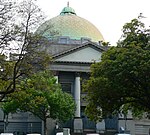Domain Park Flats
Apartment buildings in MelbourneModernist architecture in AustraliaUse Australian English from September 2015

Domain Park Flats (also referred to as Domain Park Apartments and Domain Park Towers) is a 20-storey residential building in Melbourne, Australia, completed in 1962. The block was designed by influential architect Robin Boyd CBE, one of the foremost proponents for the International Modern Movement in Australian architecture and recipient of the RAIA Gold Medal in 1969.
Excerpt from the Wikipedia article Domain Park Flats (License: CC BY-SA 3.0, Authors, Images).Domain Park Flats
Domain Road, Melbourne Melbourne
Geographical coordinates (GPS) Address Nearby Places Show on map
Geographical coordinates (GPS)
| Latitude | Longitude |
|---|---|
| N -37.834444444444 ° | E 144.98277777778 ° |
Address
Domain Road
Domain Road
3004 Melbourne, Melbourne
Victoria, Australia
Open on Google Maps








